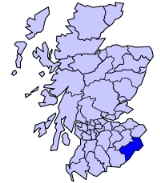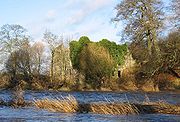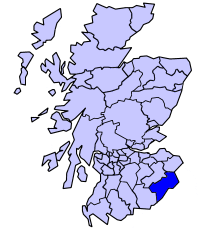
Roxburgh
Encyclopedia
Roxburgh also known as Rosbroch, is a village, civil parish
and now-destroyed royal burgh
. It was an important trading burgh
in High Medieval
to early modern
Scotland
. In the Middle Ages
it had at least as much importance as Edinburgh
, Stirling
, Perth
, or Berwick-upon-Tweed
, for a time acting as de facto capital (as royal residence of David I
).
, which allowed river transport of goods via the main seaport of Berwick-upon-Tweed. Its position also acted as a barrier to English
invasion.
The town stood on a defensible peninsula between the rivers Tweed and Teviot
, with Roxburgh Castle
guarding the narrow neck of the peninsula. Nothing remains of the town except some ruined segments of castle ramparts. Its site lies to the south of modern Kelso
and Floors Castle
, which lie on the other side of the Tweed. The Duke of Roxburghe
owns the site.
English and Scots forces repeatedly captured and recaptured the town during the Scottish Wars of Independence. Its final recapture in 1460 saw the town and castle destroyed. After this time the town never regained its importance because the final English capture of Berwick-upon-Tweed in 1482 left Roxburgh with little reason to exist.
Roxburgh was superseded as the county town
of the former county
of Roxburghshire
by Jedburgh
.
's borough".
In more recent times (1975–1996), "Roxburgh" referred to a local government district in the Borders
region of Scotland
. Its borders broadly resembled those of the traditional county of Roxburghshire
. In 1996 the district of Roxburgh became part of the Scottish Borders unitary area. (See also: Subdivisions of Scotland
)
 Nowadays the name Roxburgh belongs to a small village about 2 miles (3.2 km) south-southwest of the site of the historic Roxburgh.
Nowadays the name Roxburgh belongs to a small village about 2 miles (3.2 km) south-southwest of the site of the historic Roxburgh.
Civil parishes in Scotland
In Scotland, parishes, as units of local government, were abolished by the Local Government Act 1929. The geographical area is sometimes still referred to, however, for statistical purposes....
and now-destroyed royal burgh
Royal burgh
A royal burgh was a type of Scottish burgh which had been founded by, or subsequently granted, a royal charter. Although abolished in 1975, the term is still used in many of the former burghs....
. It was an important trading burgh
Burgh
A burgh was an autonomous corporate entity in Scotland and Northern England, usually a town. This type of administrative division existed from the 12th century, when King David I created the first royal burghs. Burgh status was broadly analogous to borough status, found in the rest of the United...
in High Medieval
High Middle Ages
The High Middle Ages was the period of European history around the 11th, 12th, and 13th centuries . The High Middle Ages were preceded by the Early Middle Ages and followed by the Late Middle Ages, which by convention end around 1500....
to early modern
Early modern period
In history, the early modern period of modern history follows the late Middle Ages. Although the chronological limits of the period are open to debate, the timeframe spans the period after the late portion of the Middle Ages through the beginning of the Age of Revolutions...
Scotland
Kingdom of Scotland
The Kingdom of Scotland was a Sovereign state in North-West Europe that existed from 843 until 1707. It occupied the northern third of the island of Great Britain and shared a land border to the south with the Kingdom of England...
. In the Middle Ages
Middle Ages
The Middle Ages is a periodization of European history from the 5th century to the 15th century. The Middle Ages follows the fall of the Western Roman Empire in 476 and precedes the Early Modern Era. It is the middle period of a three-period division of Western history: Classic, Medieval and Modern...
it had at least as much importance as Edinburgh
Edinburgh
Edinburgh is the capital city of Scotland, the second largest city in Scotland, and the eighth most populous in the United Kingdom. The City of Edinburgh Council governs one of Scotland's 32 local government council areas. The council area includes urban Edinburgh and a rural area...
, Stirling
Stirling
Stirling is a city and former ancient burgh in Scotland, and is at the heart of the wider Stirling council area. The city is clustered around a large fortress and medieval old-town beside the River Forth...
, Perth
Perth, Scotland
Perth is a town and former city and royal burgh in central Scotland. Located on the banks of the River Tay, it is the administrative centre of Perth and Kinross council area and the historic county town of Perthshire...
, or Berwick-upon-Tweed
Berwick-upon-Tweed
Berwick-upon-Tweed or simply Berwick is a town in the county of Northumberland and is the northernmost town in England, on the east coast at the mouth of the River Tweed. It is situated 2.5 miles south of the Scottish border....
, for a time acting as de facto capital (as royal residence of David I
David I of Scotland
David I or Dabíd mac Maíl Choluim was a 12th-century ruler who was Prince of the Cumbrians and later King of the Scots...
).
History
Its significance lay in its position in the centre of some of Lowland Scotland's most agriculturally fertile areas, and its position upon the River TweedRiver Tweed
The River Tweed, or Tweed Water, is long and flows primarily through the Borders region of Great Britain. It rises on Tweedsmuir at Tweed's Well near where the Clyde, draining northwest, and the Annan draining south also rise. "Annan, Tweed and Clyde rise oot the ae hillside" as the Border saying...
, which allowed river transport of goods via the main seaport of Berwick-upon-Tweed. Its position also acted as a barrier to English
England
England is a country that is part of the United Kingdom. It shares land borders with Scotland to the north and Wales to the west; the Irish Sea is to the north west, the Celtic Sea to the south west, with the North Sea to the east and the English Channel to the south separating it from continental...
invasion.
The town stood on a defensible peninsula between the rivers Tweed and Teviot
River Teviot
The River Teviot, or Teviot Water, is a river of the Scottish Borders area of Scotland, and a tributary of the River Tweed.It rises in the western foothills of Comb Hill on the border of Dumfries and Galloway...
, with Roxburgh Castle
Roxburgh Castle
Roxburgh Castle was a castle sited near Kelso, in the Borders region of Scotland, in the former Roxburghshire.-History:The castle was founded by King David I. In 1174 it was surrendered to England after the capture of William I at Alnwick, and was often in English hands thereafter. The Scots made...
guarding the narrow neck of the peninsula. Nothing remains of the town except some ruined segments of castle ramparts. Its site lies to the south of modern Kelso
Kelso, Scotland
Kelso is a market town and civil parish in the Scottish Borders area of Scotland. It lies where the rivers Tweed and Teviot have their confluence...
and Floors Castle
Floors Castle
Floors Castle, on the western outskirts of Kelso, south-east Scotland, is the seat of the Duke of Roxburghe. Despite its name it is a country house, rather than a fortress. It was built in the 1720s by the architect William Adam for the 1st Duke, possibly incorporating an earlier tower house...
, which lie on the other side of the Tweed. The Duke of Roxburghe
Duke of Roxburghe
The Duke of Roxburghe is a title in the peerage of Scotland created in 1707 along with the titles Marquess of Bowmont and Cessford, Earl of Kelso and Viscount Broxmouth. John Ker, 5th Earl of Roxburghe became the first holder of these titles...
owns the site.
English and Scots forces repeatedly captured and recaptured the town during the Scottish Wars of Independence. Its final recapture in 1460 saw the town and castle destroyed. After this time the town never regained its importance because the final English capture of Berwick-upon-Tweed in 1482 left Roxburgh with little reason to exist.
Roxburgh was superseded as the county town
County town
A county town is a county's administrative centre in the United Kingdom or Ireland. County towns are usually the location of administrative or judicial functions, or established over time as the de facto main town of a county. The concept of a county town eventually became detached from its...
of the former county
Counties of Scotland
The counties of Scotland were the principal local government divisions of Scotland until 1975. Scotland's current lieutenancy areas and registration counties are largely based on them. They are often referred to as historic counties....
of Roxburghshire
Roxburghshire
Roxburghshire or the County of Roxburgh is a registration county of Scotland. It borders Dumfries to the west, Selkirk to the north-west, and Berwick to the north. To the south-east it borders Cumbria and Northumberland in England.It was named after the Royal Burgh of Roxburgh...
by Jedburgh
Jedburgh
Jedburgh is a town and former royal burgh in the Scottish Borders and historically in Roxburghshire.-Location:Jedburgh lies on the Jed Water, a tributary of the River Teviot, it is only ten miles from the border with England and is dominated by the substantial ruins of Jedburgh Abbey...
.
Etymology
Roxburgh probably comes from Old English *hrōcas burh, "rookRook (bird)
The Rook is a member of the Corvidae family in the passerine order of birds. Named by Carl Linnaeus in 1758, the species name frugilegus is Latin for "food-gathering"....
's borough".
Roxburgh District
| Roxburgh District 1975–96 | |
 |
In more recent times (1975–1996), "Roxburgh" referred to a local government district in the Borders
Scottish Borders
The Scottish Borders is one of 32 local government council areas of Scotland. It is bordered by Dumfries and Galloway in the west, South Lanarkshire and West Lothian in the north west, City of Edinburgh, East Lothian, Midlothian to the north; and the non-metropolitan counties of Northumberland...
region of Scotland
Scotland
Scotland is a country that is part of the United Kingdom. Occupying the northern third of the island of Great Britain, it shares a border with England to the south and is bounded by the North Sea to the east, the Atlantic Ocean to the north and west, and the North Channel and Irish Sea to the...
. Its borders broadly resembled those of the traditional county of Roxburghshire
Roxburghshire
Roxburghshire or the County of Roxburgh is a registration county of Scotland. It borders Dumfries to the west, Selkirk to the north-west, and Berwick to the north. To the south-east it borders Cumbria and Northumberland in England.It was named after the Royal Burgh of Roxburgh...
. In 1996 the district of Roxburgh became part of the Scottish Borders unitary area. (See also: Subdivisions of Scotland
Subdivisions of Scotland
For local government purposes, Scotland is divided into 32 areas designated as "council areas" which are all governed by unitary authorities designated as "councils"...
)
Roxburgh village

Sources
- Sadler, JohnJohn Sadler (historian)John Sadler is a British historian specialising in the Anglo-Scottish Border conflicts during the Middle Ages. Saddler is a regular contributor to military and historical journals and has published a number of books on the subject...
, Border Fury - England and Scotland at War, 1296-1568. Pearson/Longman 2005.

